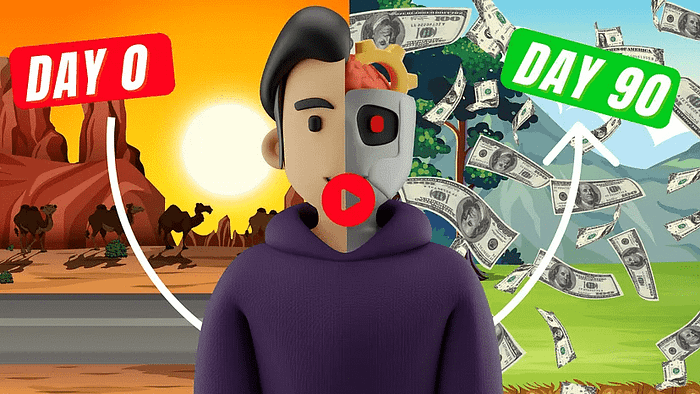Creating a digital product can be an exciting and rewarding venture, allowing you to share your knowledge, skills, or passion with a global audience.
Whether you’re an entrepreneur, freelancer, or content creator, developing a digital product can help you establish your brand, generate passive income, and make a meaningful impact on people’s lives.
In this comprehensive guide, we’ll walk you through the essential steps to create a successful digital product, from ideation to launch and beyond.
We strongly recommend that you check out our guide on how to take advantage of AI in today’s passive income economy.
Table of Contents
Identifying Your Niche and Target Audience
The first step in creating a digital product is to identify your niche and target audience.
This involves understanding your own expertise, passions, and unique value proposition, as well as researching the needs, preferences, and behaviors of your potential customers.
By focusing on a specific niche and tailoring your digital product to a well-defined target audience, you can create a more compelling and valuable offering that stands out in the market.
To identify your niche, consider your own strengths, experiences, and areas of interest.
What topics do you have in-depth knowledge or unique insights about?
What skills or expertise have you developed over time?
What are you passionate about and enjoy creating content around?
Answering these questions can help you narrow down potential niches for your digital product.
Next, research your target audience to gain a deeper understanding of their needs, challenges, and preferences.
Use online tools like social media, forums, and keyword research to gather insights into the topics, questions, and content formats that resonate with your potential customers.
Look for gaps in the market where your unique perspective and expertise can add value and differentiate your digital product from competitors.
Conducting Market Research
Before investing time and resources into creating a digital product, it’s essential to validate your idea through market research.
This involves gathering data and insights to assess the demand, competition, and potential profitability of your proposed digital product.
By conducting thorough market research, you can make informed decisions about your product strategy, pricing, and marketing approach.
Start by analyzing the current market landscape for your chosen niche and target audience.
Identify the key players, products, and content formats that are already available and popular among your potential customers.
Assess the strengths and weaknesses of existing digital products, and look for opportunities to differentiate your offering through unique features, perspectives, or delivery methods.
Next, gather feedback and insights directly from your target audience through surveys, interviews, or focus groups.
Ask questions about their needs, challenges, and preferences related to your proposed digital product.
Test your product concept and gather input on pricing, features, and content formats to ensure that your offering aligns with the expectations and willingness to pay of your target customers.
Planning and Developing Your Digital Product
Once you’ve validated your digital product idea through market research, it’s time to start planning and developing your offering.
This involves defining your product scope, creating a content outline, and choosing the appropriate format and delivery method for your digital product.
By breaking down the development process into manageable steps and setting clear goals and deadlines, you can stay organized and make steady progress towards launching your digital product.
Defining Your Product Scope and Content Outline
To create a focused and cohesive digital product, it’s essential to define your product scope and create a content outline.
Start by identifying the core topics, themes, and learning objectives that your digital product will cover.
Break down your content into chapters, modules, or sections, and create a hierarchy of main points and sub-points to guide your content creation process.
Consider the optimal length and depth of your digital product based on your target audience’s preferences and the complexity of your topic.
Aim to create a comprehensive yet accessible resource that provides value and solves specific problems for your customers.
Use your content outline as a roadmap to ensure that your digital product covers all the essential information and flows logically from one section to the next.
Choosing Your Digital Product Format and Delivery Method
The format and delivery method of your digital product can have a significant impact on its perceived value, user experience, and marketability.
Common digital product formats include ebooks, courses, templates, software, and multimedia content.
Each format has its own strengths and considerations, so it’s essential to choose the one that best aligns with your content, target audience, and business goals.
For example, if your digital product focuses on teaching a specific skill or process, an online course with video lessons, quizzes, and downloadable resources may be the most effective format.
If your product is more informational or inspirational in nature, an ebook with engaging visuals and interactive elements could be a better fit.
Consider your target audience’s preferences and learning styles, as well as your own skills and resources, when selecting your digital product format.
In terms of delivery method, you’ll need to decide how your customers will access and consume your digital product.
Options include direct download, email delivery, membership sites, online course platforms, or mobile apps.
Consider factors such as ease of use, security, scalability, and integration with your existing website or marketing channels when choosing your delivery method.
Creating High-Quality, Engaging Content
The success of your digital product ultimately depends on the quality and value of its content.
To create a compelling and effective digital product, focus on delivering engaging, informative, and actionable content that addresses your target audience’s needs and interests.
Use a clear and conversational writing style, and incorporate visual elements like images, charts, and videos to break up text and illustrate key concepts.
When creating your content, prioritize originality, depth, and practicality.
Aim to provide unique insights, examples, and strategies that go beyond surface-level information and offer real value to your customers.
Use storytelling, case studies, and personal anecdotes to make your content more relatable and memorable.
Include practical tips, templates, and exercises that help your customers apply what they learn and achieve their desired outcomes.
As you develop your digital product content, be sure to proofread, edit, and revise your work for clarity, accuracy, and flow.
Consider hiring a professional editor or soliciting feedback from beta readers in your target audience to ensure that your content is polished and effective.
Continuously update and improve your digital product over time based on customer feedback and industry trends to maintain its relevance and value.
Launching and Marketing Your Digital Product
With your digital product developed and ready to go, it’s time to plan your launch and marketing strategy.
This involves setting a launch date, creating a sales page or website, and promoting your product through various channels to attract and convert potential customers.
By executing a well-planned launch and ongoing marketing efforts, you can drive traffic, generate buzz, and establish your digital product as a valuable resource in your niche.
Setting Your Launch Date and Creating Your Sales Page
To build anticipation and momentum for your digital product launch, set a specific launch date and create a compelling sales page or website.
Your launch date should give you enough time to complete your product development, plan your marketing activities, and generate buzz among your target audience.
Consider factors like holidays, industry events, and competitor launches when selecting your launch date to maximize visibility and minimize competition.
Your sales page or website is the central hub for promoting and selling your digital product.
It should include a clear and compelling headline, a detailed description of your product’s benefits and features, social proof like testimonials and reviews, and a prominent call-to-action to purchase or sign up.
Use persuasive copywriting, engaging visuals, and a clean, user-friendly design to create a professional and trustworthy sales page that converts visitors into customers.
Promoting Your Digital Product Through Multiple Channels
To reach and attract your target audience, promote your digital product through a variety of marketing channels.
This can include email marketing, social media, content marketing, paid advertising, and partnerships or affiliates.
By leveraging multiple channels and tactics, you can expand your reach, build brand awareness, and drive targeted traffic to your sales page.
Start by building an email list of potential customers who have expressed interest in your niche or product.
Use lead magnets, opt-in forms, and landing pages to capture email addresses, and nurture your subscribers with valuable content and promotional offers leading up to your launch.
Segment your email list based on interests and behaviors to deliver more targeted and effective marketing messages.
Leverage social media platforms like Twitter, Facebook, and LinkedIn to share updates, teasers, and behind-the-scenes content related to your digital product launch.
Use relevant hashtags, engage with your followers, and run social media ads to expand your reach and drive traffic to your sales page.
Collaborate with influencers, bloggers, or other experts in your niche to tap into their audiences and generate buzz around your product launch.
Create valuable and shareable content related to your digital product topic, such as blog posts, videos, infographics, or webinars.
Use SEO best practices to optimize your content for search engines and attract organic traffic to your website.
Promote your content through social media, email newsletters, and guest posting on relevant industry blogs or publications.
Consider running paid advertising campaigns on platforms like Google AdWords, Facebook Ads, or native advertising networks to drive targeted traffic to your sales page.
Use compelling ad copy, visuals, and targeting options to reach your ideal customers and maximize your return on investment.
Monitor and adjust your ad campaigns based on performance data to optimize your results over time.
Finally, explore partnerships or affiliate programs to expand your reach and generate additional revenue streams for your digital product.
Identify complementary products, services, or influencers in your niche, and propose mutually beneficial collaboration or commission arrangements.
By leveraging the audiences and expertise of partners or affiliates, you can tap into new markets and drive more sales for your digital product.
Conclusion
Creating a successful digital product requires careful planning, research, and execution across multiple stages, from ideation to launch and beyond.
By following the steps outlined in this guide, you can identify a profitable niche, develop a high-quality and valuable product, and effectively promote and sell it to your target audience.
Remember to continuously monitor your results, gather customer feedback, and iterate on your digital product strategy to ensure long-term success and growth in your chosen market.
FAQ
What are digital products examples?
Digital-products are intangible goods that are created, delivered, and consumed electronically. Some common examples of digital-products include:
- Ebooks
- Online courses
- Software and mobile apps
- Digital templates and printables
- Stock photos and graphics
- Music and audio files
- Videos and digital movies
- Membership sites and subscription-based content
- Digital art and designs
- Webinars and virtual events
What are the 4 categories of digital products?
Digital-products can be broadly categorized into four main types:
- Educational products: These include ebooks, online courses, webinars, and tutorials that teach specific skills, knowledge, or processes.
- Entertainment products: These include digital media like music, movies, TV shows, podcasts, and video games that provide enjoyment and leisure.
- Productivity products: These include software, mobile apps, templates, and tools that help users perform tasks, manage projects, or improve efficiency.
- Lifestyle products: These include digital products related to personal interests, hobbies, or self-improvement, such as fitness plans, recipe books, or virtual coaching services.
How do you define a digital product?
A digital-product is any product that is created, delivered, and used in a digital format, without a physical component. Digital-products are typically intangible goods that can be accessed and consumed through electronic devices like computers, smartphones, or tablets. They are often delivered through the internet, either as a one-time download or as an ongoing service, and can be easily replicated and distributed to a global audience without the need for physical inventory or shipping.
How do I start a digital product?
To start a digital-product, follow these key steps:
- Identify your niche and target audience based on your expertise, interests, and market demand.
- Conduct market research to validate your product idea and gather insights into your target customers’ needs and preferences.
- Define your product scope and create a detailed content outline to guide your development process.
- Choose the appropriate format and delivery method for your digital-product based on your content, audience, and business goals.
- Create high-quality, engaging, and valuable content that addresses your target audience’s needs and interests.
- Set a launch date and create a compelling sales page or website to promote and sell your digital-product.
- Promote your digital-product through multiple marketing channels, such as email marketing, social media, content marketing, paid advertising, and partnerships or affiliates.
- Continuously monitor your results, gather customer feedback, and iterate on your digital-product strategy to ensure long-term success and growth.

We strongly recommend that you check out our guide on how to take advantage of AI in today’s passive income economy.




